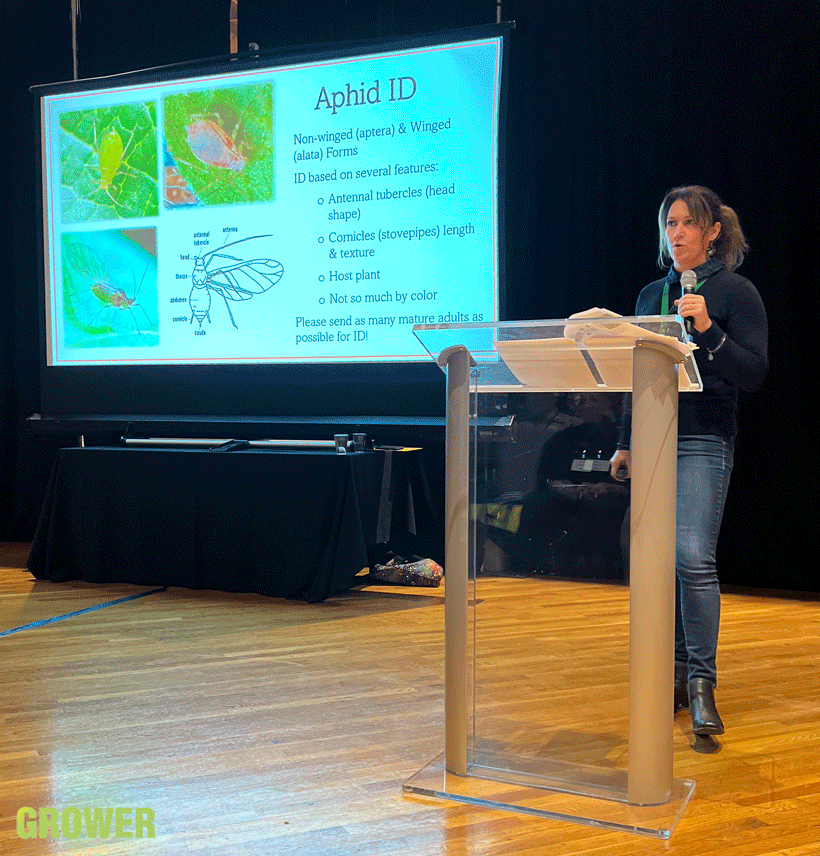A high tunnel can create an ideal environment for plants to grow, but it can also allow unwanted pests to thrive. Research Assistant Professor at the University of Vermont Cheryl Frank Sullivan explained how many of these pests can create a “total visual food quality issue” and must be managed right away to prevent widespread infestation.
Sullivan has conducted research on aphid infestations in high tunnel tomatoes. A farmer can self-diagnose their pest as aphids, based on the pest appearance, the presence of cast skins (skin they’ve molted while moving to their next life stage), the plant damage/distortion and the presence of “honeydew” (aphid poop). However, identifying the species of aphid is much more difficult, as the main distinguishing feature is their head shape.
Four of the most common species are the foxglove, potato, melon and green peach aphids. When sending samples to a lab to identify the species, “it’s really important that you send as many of them as possible,” said Sullivan, as it’s easier to identify fully mature aphids. The species cannot be distinguished based on color, as color is mostly due to genetics and the aphids’ diet, not the species itself.
After identifying your pest, “the first step in preventing aphid apocalypse” is knowing their biology and tracking when they’re a problem. What do their life stages look like? In which life stage are they causing damage to your crop? What does the damage look like? Where on the plant is the damage occurring? What time of year is the damage occurring?
IPM is the best way to control an aphid outbreak, with prevention as the “first line of defense.” Try to prevent aphids from entering your high tunnel in the first place. Sullivan explained, “A lot of times they hitchhike on plant material,” but they can also fly in from the outside and carry on from previous crops.

Cheryl Frank Sullivan, a research assistant professor at UVM, discussed the issue of aphids in high tunnels. Photo by Kelsi Devolve
Some great prevention methods include fallowing, managing your weeds, training staff on how to identify an outbreak, scouting and avoiding crop rotations in an infested tunnel. Scouting can help determine how many plants are infested and at what magnitude. Once you know the severity of the infestation, you can determine how aggressive your removal technique needs to be.
To properly prevent an aphid outbreak, “timing is everything,” Sullivan said, and “scouting … really helps you get that timing right.” Great scouting strategies include monitoring at regular intervals, writing everything down and flagging infested areas. Scouting should take place through the entire growing season to be sure any prevention/removal plans in place are still effective.
Integrating beneficial insects into the high tunnel can be an effective pest control strategy. Aphids have many natural enemies, both predator and parasite. These beneficial insects can only succeed when they are living in ideal conditions and are being supported to survive, though.
Growers can incorporate a plant-mediated IPM system that can either provide food and shelter for the natural enemies (habitat planting) or provide an ongoing supply of natural enemies (banker planting). The predators Sullivan sees the most are the predatory flies Aphidoletes aphidimyza, which “do wonders once they’re established.”
If turning to pesticides to help control the aphid population, Sullivan urges growers to read the label to make sure it’s used responsibly, safely and effectively.
Double check that the pesticide will not affect the plants’ ability to grow and be sold/consumed, won’t hurt the beneficial insects and won’t conflict with other pesticides or methods currently in use.
It’s important to remember that “biocontrol success takes time and effort” and it’s best to start with a plan in place.
by Kelsi Devolve

